Abstract
Breast cancer is the most common cancer among women and just last year, two million new cases were diagnosed worldwide. In every 15 seconds, a woman diagnosed with breast cancer somewhere in the world and more than six women die of breast cancer every five minutes worldwide. Three most common cancers among women were breast, colorectal and cervix. These shocking figures only serve to underline the fact that many women today will be facing a battle with breast cancer at some point in their lives. Fearing of the increasing number of breast cancer patients with higher stage, this study conducted to look at the level of awareness among chosen sample. This study will apply the quantitative method through surveys and questionnaires. The confirmatory by the purposive sampling through semi structure interview with Medical Institutions, which is Hospital Tengku Ampuan Afzan, Kuantan Pahang This study will help the government and policymakers especially Ministry of Health, Malaysia to analyze the factors that could increase citizens’ awareness in dealing with breast cancer at early stage. Finally, this study will help to improve the wellbeing of the people and align to the social re-engineering dimension was highlighted in the 12th Malaysia’s Plan.
Keywords: Cancerawarenessbreast cancermedical institutions
Introduction
Cancer among women with two million new cases were diagnosed worldwide last year. A woman is diagnosed with breast cancer somewhere in the world in every 15 seconds and more than six women die of breast cancer every five minutes worldwide. These shocking figures only serve to underline the fact that many women today will be facing a battle with breast cancer at some point in their lives (Murugesan, 2019).
Over 90% of breast cancer patients look for restorative medical consideration just at last stages (Mohiuddin et al., 2012; Story et al., 2012) and the result, practically all breast cancer cases are identified clinically. There are many screening techniques like mammogram, breast self-examination, and so forth., which helps individuals in early location however about 77% of the individuals were uninformed of breast cancer screening strategies (Özaras et al., 2010). To be noted, absence of information about how to identify the ailment at a beginning period would conceivably prompt misguided judgments with respect to its reparability and the viability of early recognitions (Dandash & Al-Mohaimeed, 2007).
Emphasis on early screening of breast cancer helps in earlier diagnosis and higher survival rates, and it has been estimated that a 100% survival rate is achievable for stages 0 and 1 of breast cancer cases. Early diagnosis of female breast cancer can be achieved by mass screening, mammography, Clinical Breast Examination (CBE) and self-breast examination (SBE) or by the combination of three (Venkatramana et al., 2011). As shown in Figure
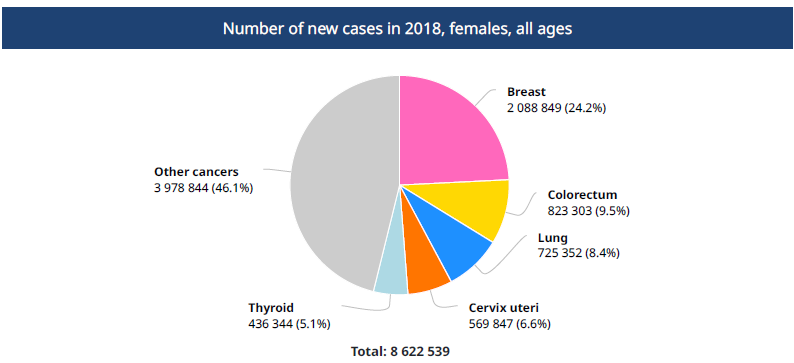
Campaign
For a decade, the Healthy Lifestyles Campaign been introduced to the community in line with an effort to support healthy lifestyles and reduce the chances of getting dangerous diseases. Breast Health Awareness also been introduced together with Breast Self-Examination (BSE), suggestion to perform an annual clinical breast examination (CBE) for those who reach 40 years old and mamogram for those who reach 50 years old. This campaign emphasizes the importance of being screen for breast cancer as well as recognizing the key signs and symptoms. Many women are aware that lumps are warning signs for breast cancer. However, few women know that symptoms such as skin dimpling turned in nipples and discharge from nipples can be signs of breast cancer (Tin, 2018).
Breast Self-Examination (BSE)
Breast Self-Examination (BSE) is a screening method to detect breast cancer early. Although breast self-examination increases the number of biopsies performed on women, it does not reduce mortality from breast cancer. In a large clinical trial involving more than 260,000 female Chinese factory workers, half were carefully taught by nurses at their factories to perform monthly breast self-exam, and the other half were not. The women taught self-exam detected more benign (normal or harmless lumps) or early-stage breast disease, but equal numbers of women died from breast cancer in each group (Thomas et al., 2002).
Problem Statement
Breast cancer can be considered as the most common cause of death to Malaysian women. Every year, there is an increasing number of cases being recorded with some of them at later stage. The reasons behind this could be because of the lack of information and campaign reaching the community that lead to lack of knowledge related to the symptoms, BSE, the screening procedure and also other related factors that increase the chances of the community not being treated wisely and accordingly. According to Health Minister, Datuk Seri Dr Dzulkefly Ahmad, 60% of cancer cases being detected at later stage because of lack of awareness with the most common cancers among women are breast (32.1%), colorectal (10.7%) and cervical (7.7%) (NST, 2019).
Research Questions
The research questions for this study are as follows:
This study aims to evaluate whether the respondents aware about breast cancer program, about the self-examination (BSE), aware about the knowledge related to breast cancer and awareness related to the screening related to breast cancer. This study also aims to evaluate about:
How much percentage of the level awareness among the public towards breast cancer program?
Why there is no follow up procedures if there is the possibility of any abnormality after Breast Self - Examination?
Purpose of the Study
The purpose of this study can be outlined as follows:
To measure the the level awareness among the public towards breast cancer program
To explore follow up procedures if there is the possibility of any abnormality after Breast Self – Examination.
Research Methods
This study utilizes quantitative methods based on surveys, expert opinion, and literature and existing knowledge in this area. A total of 55 respondents involved in this study were access thru online and physical questionnaire distributed to people of Pahang. The study accompanied various level of sample with breast cancer experience and those who did not experience any cancer cases.
The data were collected using structured questionnaire developed been adopted from the questionnaire used by Madubogwu et al. (2017). The questions have been divided into a few sections namely sociodemographic, knowledge related to breast cancer (BC), the practice, and knowledge related to clinical test for BC. Sociodemographic sections cover questions related to marital status, job, education level, and age. The survey aims to analyse whether respondents aware about BC and to analyze their basic knowledge related to BC and clinical test of BC.
Findings
This questionnaire been answered by the respondents in Pahang. The number of responds receives were 55 with age ranging between 20 to 51 years old.
Discussion on the level of academic
Based on Figure
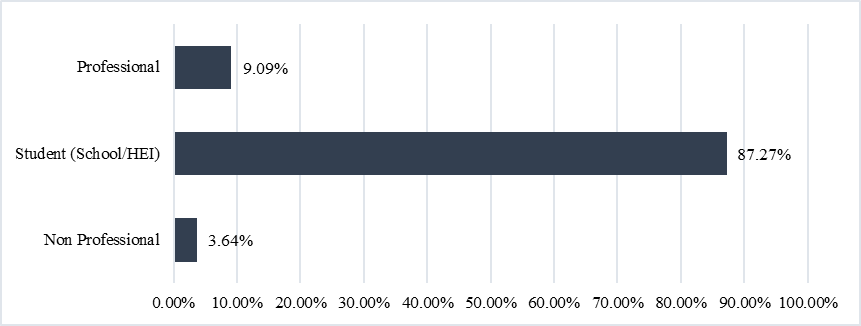
Discussion on the level of government campaign towards Breast Cancer
Based on the Figure
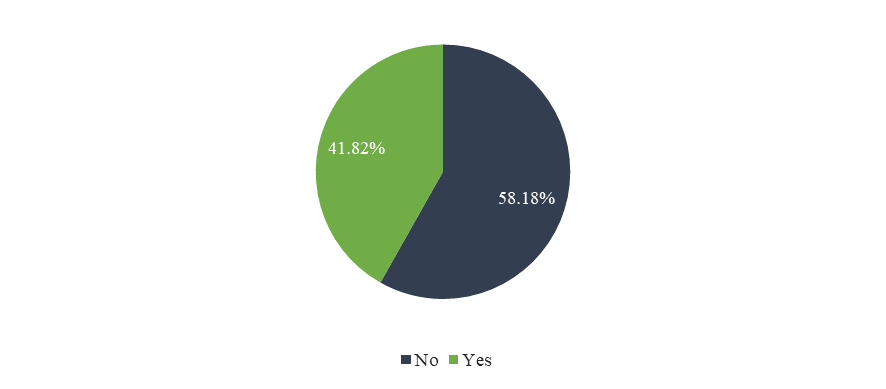
Discussion on the medium of communication they are being exposed with Breast Self-Examination
Based on the Figure
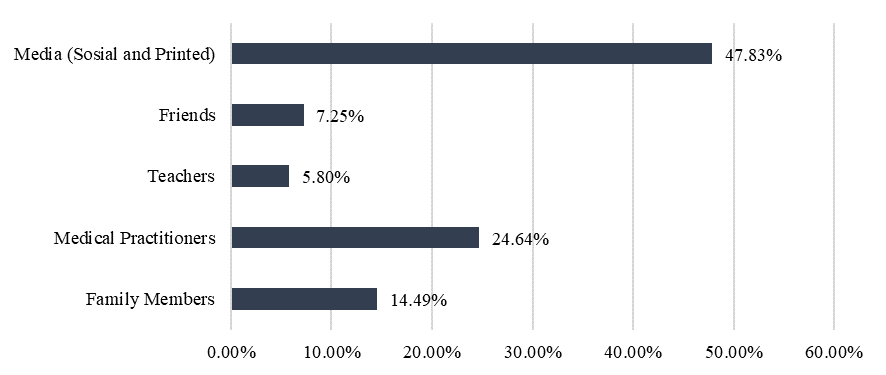
Discussion on Action taken after Breast Self-Examination abnormality
Regardless on lack of awareness on breast cancer symptoms in Malaysia, but the Figure
The argument on 27.3% still not taking any action after Breast Self-Examination caused by the personal issues such as unready mentally and physically to face the situation, still thinking can be cured by using traditional ways and unsupported family members to face the unhealthy condition.
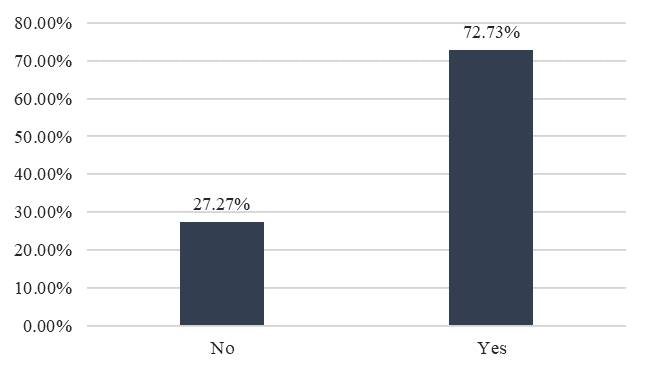
Discussion on why the Breast Cancer Patients choose to stop makes further action
There are several arguments why Breast Cancer Patients choose to stop make further action, Figure
Second major contributions 16.7 % comes from the factor of when they can’t see any severe effect after being diagnosed as breast cancer patients. This could indicate the lack of awareness and uneducated level of cancer patients in combating the breast cancer.
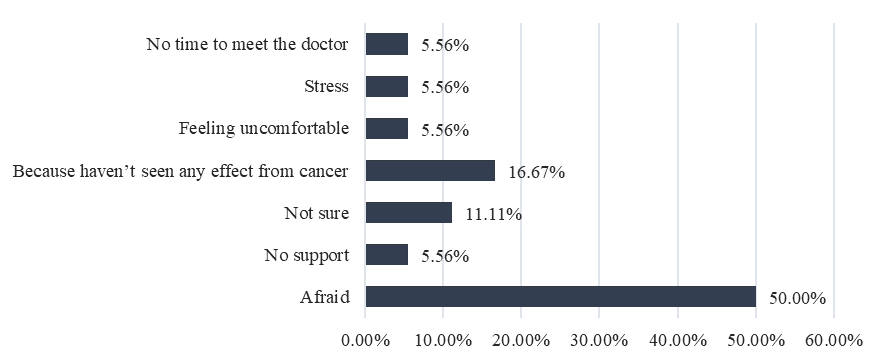
Conclusion
The level of awareness towards Early Detection of Breast Cancer should be improved from time to time; this may prevent the increasing of number of death. Breast cancer patients should be given motivation from the spouse and family to face the disease. This result will contribute by enhancing the level of awareness about cancer to society and develop a cancer-ready society by distributing knowledge about symptoms of cancers and the possible treatments.
References
- Dandash, K. F., & Al-Mohaimeed, A. (2007). Knowledge, attitudes, and practices surrounding breast cancer and screening in female teachers of Buraidah, Saudi Arabia. International Journal of Health Sciences, 1(1), 61–71.
- Madubogwu, C. I., Egwuonwu, A. O., Madubogwu, N. U., & Njelita, I. A. (2017). Breast cancer screening practices amongst female tertiary health worker in Nnewi. Journal of Cancer Research and Therapeutics, 13(2), 268.
- Murugesan, M. (2019, February 28). Beating the odds in breast cancer. https://www.nst.com.my/lifestyle/heal/2019/02/464498/beating-odds-breast-cancer
- Mohiuddin, M., Gafur, M. A., Karim, M. R., Khan, S. A., Hoque, M. M., Islam, M. S., & Ali, M. S. (2012). Clinicopathological stages of carcinoma breast patient. Mymensingh medical journal: MMJ, 21(2), 238-245. https://europepmc.org/article/med/22561765
- Özaras, G., Durualp, E., Civelek, F. E., Gül, B., & Ünsal, M. (2010). Analysis of breast self-examination training efficiency in women between 20-60 years of age in Turkt. Asian Pacific Journal of Cancer Prevention, 11(3), 799–802.
- Story, H. L., Love, R. R., Salim, R., Roberto, A. J., Krieger, J. L., & Ginsburg, O. M. (2012). Improving outcomes from breast cancer in a low-income country: lessons from Bangladesh. International Journal of Breast Cancer, 423562. https://doi.org/10.1155/2012/423562
- Thomas, D. B., Gao, D. L., Ray, R. M., Wang, W. W., Allison, C. J., Chen, F. L., Porter, P., Hu, Y. W., Zhao, G. L. Pan, L. D., Li, W., Wu, C., Coriaty, Z., Evans, I., Lin, M. G., Stalsberg, H., Self, S. G., & Li, W. (2002). Randomized trial of breast self-examination in Shanghai: final results. J. Natl. Cancer Inst., 94(19), 1445-57. https://doi.org/10.1093/jnci/94.19.1445
- Venkatramana, M., Sreedharan, J., Muttappallymyalil, J., & Thomas, M. (2011). Opinion of Nurses Regarding Breast Cancer Screening Programs. Indian Journal of Cancer, 48, 423-427. https://doi.org/10.4103/0019-509X.92262
Copyright information

This work is licensed under a Creative Commons Attribution-NonCommercial-NoDerivatives 4.0 International License.
About this article
Publication Date
30 December 2020
Article Doi
eBook ISBN
978-1-80296-099-0
Publisher
European Publisher
Volume
100
Print ISBN (optional)
-
Edition Number
1st Edition
Pages
1-905
Subjects
Multi-disciplinary, accounting, finance, economics, business, management, marketing, entrepreneurship, social studies
Cite this article as:
Abd Razak, S. F. F. B., & Abdul Manaf, N. B. (2020). Knowledge And Consciousness Of Malaysian Citizens In Coping With Breast Cancer. In N. S. Othman, A. H. B. Jaaffar, N. H. B. Harun, S. B. Buniamin, N. E. A. B. Mohamad, I. B. M. Ali, N. H. B. A. Razali, & S. L. B. M. Hashim (Eds.), Driving Sustainability through Business-Technology Synergy, vol 100. European Proceedings of Social and Behavioural Sciences (pp. 413-419). European Publisher. https://doi.org/10.15405/epsbs.2020.12.05.44

